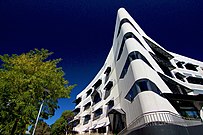This article needs additional citations for verification. (May 2023) |
Tertiary education in Australia is formal education beyond high school in Australia, consisting of both government and private institutions and divided into two sectors; Higher Education (provided by universities) and Vocational Education and Training (VET) provided by government-owned TAFEs & private Registered Training Organisations (RTO).[1][2] Australian Qualifications Framework (AQF), the Australian national education policy, classifies tertiary qualification into 10 levels: level 1 to 4 vocational certificates (I - IV); level 5 & 6 undergraduate diploma and advanced diploma; level 6 associate degree; level 7 bachelor degree, level 8 bachelor honours degree & graduate certificates and graduate diplomas; level 9 for master's degree; and level 10 PhD. Most universities are government owned and mostly self-regulated. For other institutes (VETs, i.e. TAFE & RTO) there are two national regulators for tertiary education for registration, recognition and quality assurance of both the "provider institutes" as well as the "individual courses" provided by the providers. Tertiary Education Quality and Standards Agency (TEQSA) regulates institutes which provide education from level 5 or above. Australian Skills Quality Authority (ASQA) regulates institutes which provide education from level 1 to level 6.[3]
For admission in Australian institutes, Australian & New Zealand citizens or Australian permanent residents, are considered the "domestic students" regardless of whether they did the prior schooling in Australia or overseas. All others are considered the "international students".[4] Domestic students need to apply only once to the TACs (State-based unified Tertiary Admission Center) of the relevant state for admission to all the universities within that state, which grant admission based on the ATAR-based "Selection Rank" (SR). Those students with International Baccalaureate (IB), both domestic and international students, must apply to the "Australasian Conference of Tertiary Admission Centres" (ACTAC) which calculates an Australia-wide ATAR-like national rank called "Combined Rank" (CR).[5] Domestic students usually pay lot less subsidised-fees compared to the International students. Additionally, the domestic students are entitled to publicly funded universal health care insurance scheme Medicare, Pharmaceutical Benefits Scheme (PBS) and various social security welfare payments & benefits, e.g. Austudy Payment, Youth Allowance, etc., to meet the living expenses. The international students are not entitled to these benefits. All international students apply individually to each University, and most international students are self-financed non-subsidised full-fee paying students.
There are 43 universities registered in Australia (including 37 public universities, four private universities, and one international private university).[6][7] Many Australian universities have formed several network groupings, such as Group of Eight (8 leading universities which receive two thirds of the government research grant funding awarded to all universities), Australian Technology Network (ATN), Innovative Research Universities (IRU), Regional Universities Network (RUN), and more.[8]
Australia is well known for high quality education, most of the universities are government owned, and they rank very highly on the global rankings. Australia is ranked 4th (with Germany) by OECD in international PhD students destination after US, UK and France.[9] Australia has a comparatively high proportion of international students as a percentage of students enrolled, at 26.5% in 2018.[10] Australia has the fifth-highest number of foreign students worldwide.[11] The 56% of 462,033 international students in Australia are from top-5 nations; China (23%), India (16%), Nepal (10%), Colombia (4%) and Thailand (3%) with enrollment ratio of 50% in Higher Education (229,833), 35% VET (162,193), 11% ELICOS English language course (50,246), 2% Schools (19,704) and 2% Non-Award (8,057).[12] In 2022, 69% of Australians aged 20–64 had a tertiary qualification, and 24% had multiple qualifications.[1] Among all the ethnic groups in Australia, the Indian Australians are the highest educated group in Australia with 54.6% having a bachelor's or higher degree, more than three times Australia's national average of 17.2%.[13]
- ^ a b "Education and Work, Australia, May 2020 | Australian Bureau of Statistics". www.abs.gov.au. 11 November 2020. Retrieved 7 July 2021.
- ^ "Qualifications and work, 2018-19 financial year | Australian Bureau of Statistics". www.abs.gov.au. 29 September 2020. Retrieved 7 July 2021.
- ^ Australian qualifications framework explanation, www.teqsa.gov.au, accessed 4 aug 2023.
- ^ "Australian students studying overseas". www.unimelb.edu.au. 18 May 2023. Retrieved 18 May 2023.
- ^ Improving IB entry to Australian tertiary courses, IB combined rank.
- ^ Cite error: The named reference
teqsa.gov.auwas invoked but never defined (see the help page). - ^ PMC, Education. "Higher Education Support Act 2003". www.legislation.gov.au. Retrieved 7 July 2021.
- ^ "University research funding: a quick guide".
- ^ "Subscribe to the Australian | Newspaper home delivery, website, iPad, iPhone & Android apps".
- ^ "Students - International student mobility - OECD Data". theOECD. Retrieved 7 July 2021.
- ^ "Project-Atlas-Infographics-2020.pdf". iie.widen.net. Retrieved 7 August 2021.
- ^ YTD January 2023 international student data available, Mar 2023, Austrade, 30 Mar 2023.
- ^ "Indians found to be Australia's most highly educated migrants - Interstaff Migration". 19 August 2016.




